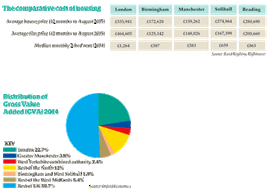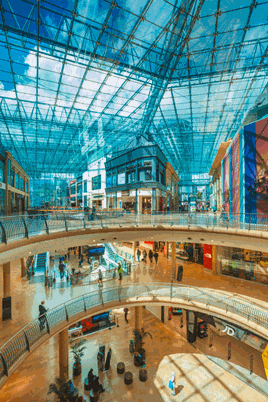“So we had to figure out what did HS2 really mean? What were the real opportunities for the region from HS2? We started to explore the opportunities that would be offered by the releasing of capacity on the West Coast Main Line, what that would mean for freight and on the road network around the region.”
Rather like a jigsaw puzzle then, where once the first piece was in place the others followed?
“In a way, but someone stole the lid, unfortunately! We started to look at it from a perspective of people, business and place, which is historically what the LEP’s core principles have been - we tried to engage with as many regional partners as possible. I came on board in November of last year, so we had three or four months to pull this together.”
Those three strands - People, Business and Place - run through the strategy with each split into short, medium and long-term objectives. For example, the People strategy aims to ensure that contractors can recruit locally, with the rail college forming a central pillar to educate the workforce. The area has a diverse and comparatively young population, which is seen as a key asset. There’s a desire for school leavers to be fully aware of, and ready for, the career opportunities resulting from the construction of HS2.
Meanwhile, the Business strand wants companies to be drawn to the area, supported to recruit locally, and to enjoy ‘unrivalled connectivity’ to expanded markets and to world-class research and technology. Before the rails arrive, however, it’s recognised that the supply chain will need to be strengthened to enable the Midlands to be a key player.
Finally, the Place strand aims to create two landmark stations, with accompanying internationally renowned development zones, integrated into local transport networks. Low-carbon solutions and ‘enhanced green infrastructure’ are also listed in the key outcomes.
Wakeman responds instantly when asked which of the ‘three legs of the stool’ is the most important: “People. We have an opportunity here to put in place things for future generations, for learning, for employment. We’re building a sustainable economic strategy. When Brunel laid the first tracks 150 years ago it stimulated the Industrial Revolution of the time. This is about the industrial revolution of the 21st century. HS2 is a massive catalyst to maximise the growth potential in this region.”
The LEP doesn’t have numbers for businesses that have already moved to the area ahead of high-speed services starting, but it does offer plenty of anecdotal evidence. As it launched the growth strategy document, it canvassed those in the area.
 James Hunter Johnston, of NVC Lighting (a Chinese manufacturer), said. “The arrival of HS2 is already bringing about a sense of opportunity in the Midlands. It will bring the region closer to Europe so that it will become a viable location for NVC Lighting’s European headquarters, allowing us to escape the high operational costs in London.”
James Hunter Johnston, of NVC Lighting (a Chinese manufacturer), said. “The arrival of HS2 is already bringing about a sense of opportunity in the Midlands. It will bring the region closer to Europe so that it will become a viable location for NVC Lighting’s European headquarters, allowing us to escape the high operational costs in London.”
Matthew Cheyne, head of sales and marketing at MG Motor UK, said: “Transport links are vital to help businesses grow. Better transportation links will help us drive forward, by improving communications and helping to draw people to the new vibrant city of Birmingham and the fantastic surrounding areas. Success breeds success, and our region being linked to the rest of the UK by HS2 will give MG and Birmingham even greater pulling power for forward-looking, talented people.”
Getting industry to opt in now is important, says Wakeman. “We have concrete evidence of companies moving to the area. We’re getting a lot of noise from people who say they are interested in coming over. It’s clear people recognise the opportunity. We’re looking to work with anybody who wants to move to the region to benefit - not just for the arrival of HS2, because that’s just the catalyst, but also the current economic growth that’s happening here and being sustained.”
Of course, more people means more infrastructure to support them. The LEP has addressed this by including a garden city in the strategy, an idea developed by Solihull Metropolitan Borough Council. Two thousand houses, potentially home to a population of between 4,000 and 5,000 people, will be built close to the HS2 interchange station, on a site covering more than 140 hectares.
The prospectus for this development is also not short on ambition. “Innovative designs including green bridges, connecting neighbourhoods and major infrastructure” are promised, along with green spaces and community energy and heating plans. All of this will be connected into business zones and (of course) the station itself. It also means more schools, shops, leisure activities, and so on.
Says Wakeman: “Solihull has always been keen on addressing the housing shortage in the borough. Everyone accepts there is a need for additional housing. We have to acknowledge there is a housing shortage in this region, and we have to be imaginative in how we look at addressing that, and this could be one such opportunity.”
Returning to the Savills real estate report, it believes Birmingham needs an estimated 89,000 new homes by 2031. At current rates of delivery, it thinks there will be a shortfall of 26,000 when HS2 opens, and so is calling for 4,450 new homes to be built each year. In the year to March 2015, only 1,810 net additional homes were added.
“Increased demand, coupled with an improved local economy and the gradual influx of wealth, both in the shape of London commuters’ salaries and a greater number of higher salaried roles, is expected to drive up house prices over time, particularly at the top end of the market,” says Susan Emmett, director of Savills residential research.
Meanwhile, you can’t ignore the fact that the site chosen for the HS2 interchange station is already a crowded transport hub. On weekdays the M42 and M6 interchange are notoriously busy. At weekends, with several shows on at the National Exhibition Centre, the motorway and Birmingham International station heave with travellers - and that’s before the adjacent airport is considered. This is a truly global aviation hub which this year has had passenger growth of 5%. In 2015 it has handled ten million passengers for the first time in its history. When HS2 switches on, it will be just a shade over 30 minutes from central London, almost comparable with a trip from the capital to Gatwick. The airport’s own study thinks an extra 750,000 passengers will be tempted to use it.












